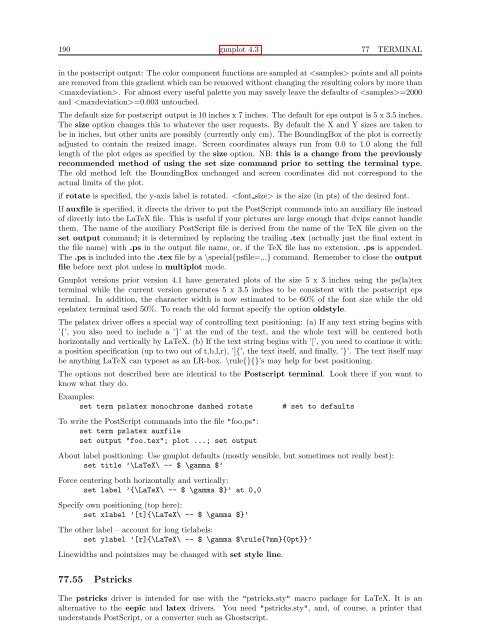gnuplot documentation
gnuplot documentation
gnuplot documentation
You also want an ePaper? Increase the reach of your titles
YUMPU automatically turns print PDFs into web optimized ePapers that Google loves.
190 <strong>gnuplot</strong> 4.3 77 TERMINAL<br />
in the postscript output: The color component functions are sampled at points and all points<br />
are removed from this gradient which can be removed without changing the resulting colors by more than<br />
. For almost every useful palette you may savely leave the defaults of =2000<br />
and =0.003 untouched.<br />
The default size for postscript output is 10 inches x 7 inches. The default for eps output is 5 x 3.5 inches.<br />
The size option changes this to whatever the user requests. By default the X and Y sizes are taken to<br />
be in inches, but other units are possibly (currently only cm). The BoundingBox of the plot is correctly<br />
adjusted to contain the resized image. Screen coordinates always run from 0.0 to 1.0 along the full<br />
length of the plot edges as specified by the size option. NB: this is a change from the previously<br />
recommended method of using the set size command prior to setting the terminal type.<br />
The old method left the BoundingBox unchanged and screen coordinates did not correspond to the<br />
actual limits of the plot.<br />
if rotate is specified, the y-axis label is rotated. is the size (in pts) of the desired font.<br />
If auxfile is specified, it directs the driver to put the PostScript commands into an auxiliary file instead<br />
of directly into the LaTeX file. This is useful if your pictures are large enough that dvips cannot handle<br />
them. The name of the auxiliary PostScript file is derived from the name of the TeX file given on the<br />
set output command; it is determined by replacing the trailing .tex (actually just the final extent in<br />
the file name) with .ps in the output file name, or, if the TeX file has no extension, .ps is appended.<br />
The .ps is included into the .tex file by a \special{psfile=...} command. Remember to close the output<br />
file before next plot unless in multiplot mode.<br />
Gnuplot versions prior version 4.1 have generated plots of the size 5 x 3 inches using the ps(la)tex<br />
terminal while the current version generates 5 x 3.5 inches to be consistent with the postscript eps<br />
terminal. In addition, the character width is now estimated to be 60% of the font size while the old<br />
epslatex terminal used 50%. To reach the old format specify the option oldstyle.<br />
The pslatex driver offers a special way of controlling text positioning: (a) If any text string begins with<br />
’{’, you also need to include a ’}’ at the end of the text, and the whole text will be centered both<br />
horizontally and vertically by LaTeX. (b) If the text string begins with ’[’, you need to continue it with:<br />
a position specification (up to two out of t,b,l,r), ’]{’, the text itself, and finally, ’}’. The text itself may<br />
be anything LaTeX can typeset as an LR-box. \rule{}{}’s may help for best positioning.<br />
The options not described here are identical to the Postscript terminal. Look there if you want to<br />
know what they do.<br />
Examples:<br />
set term pslatex monochrome dashed rotate<br />
To write the PostScript commands into the file "foo.ps":<br />
set term pslatex auxfile<br />
set output "foo.tex"; plot ...; set output<br />
# set to defaults<br />
About label positioning: Use <strong>gnuplot</strong> defaults (mostly sensible, but sometimes not really best):<br />
set title ’\LaTeX\ -- $ \gamma $’<br />
Force centering both horizontally and vertically:<br />
set label ’{\LaTeX\ -- $ \gamma $}’ at 0,0<br />
Specify own positioning (top here):<br />
set xlabel ’[t]{\LaTeX\ -- $ \gamma $}’<br />
The other label – account for long ticlabels:<br />
set ylabel ’[r]{\LaTeX\ -- $ \gamma $\rule{7mm}{0pt}}’<br />
Linewidths and pointsizes may be changed with set style line.<br />
77.55 Pstricks<br />
The pstricks driver is intended for use with the "pstricks.sty" macro package for LaTeX. It is an<br />
alternative to the eepic and latex drivers. You need "pstricks.sty", and, of course, a printer that<br />
understands PostScript, or a converter such as Ghostscript.

















